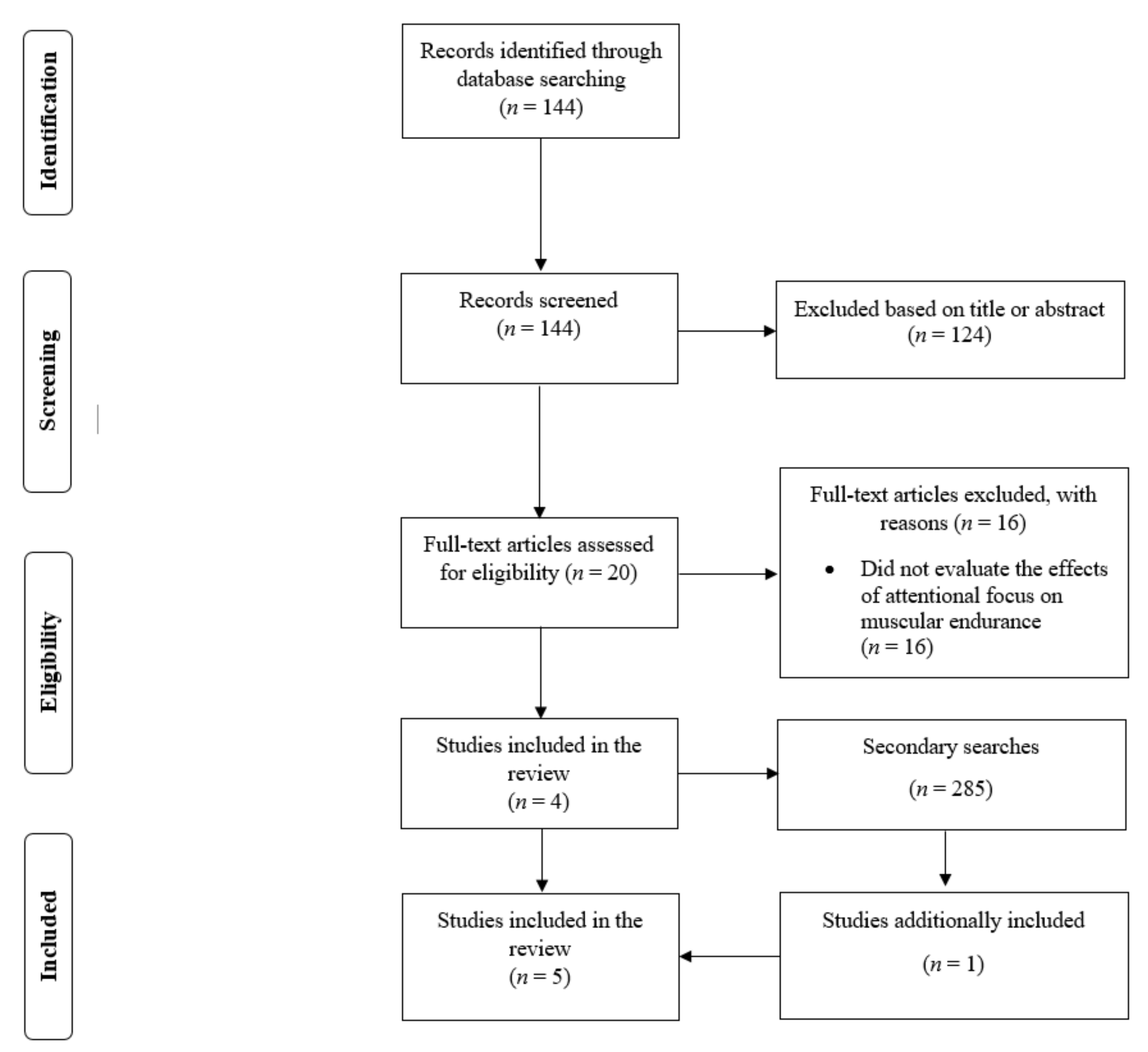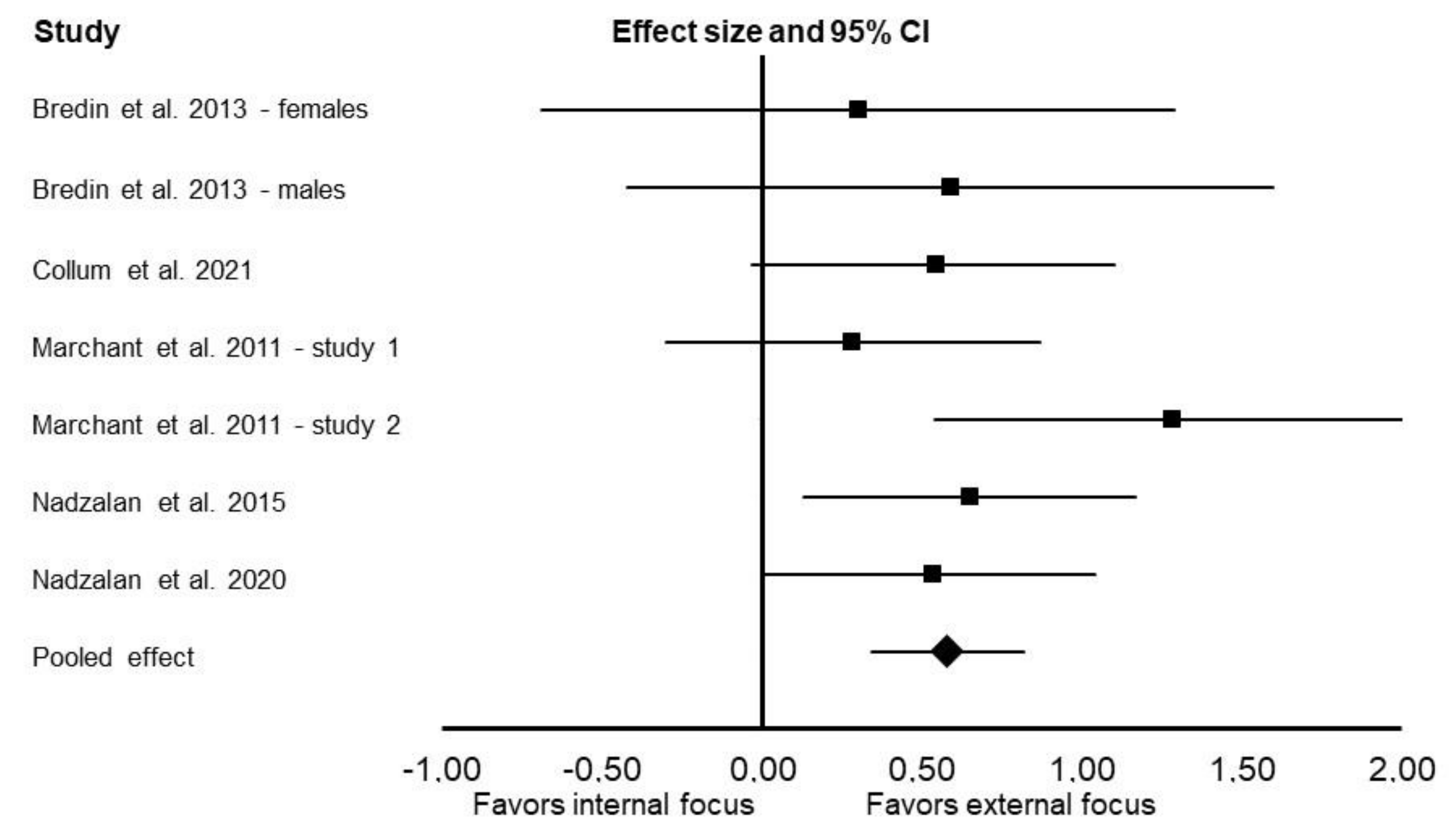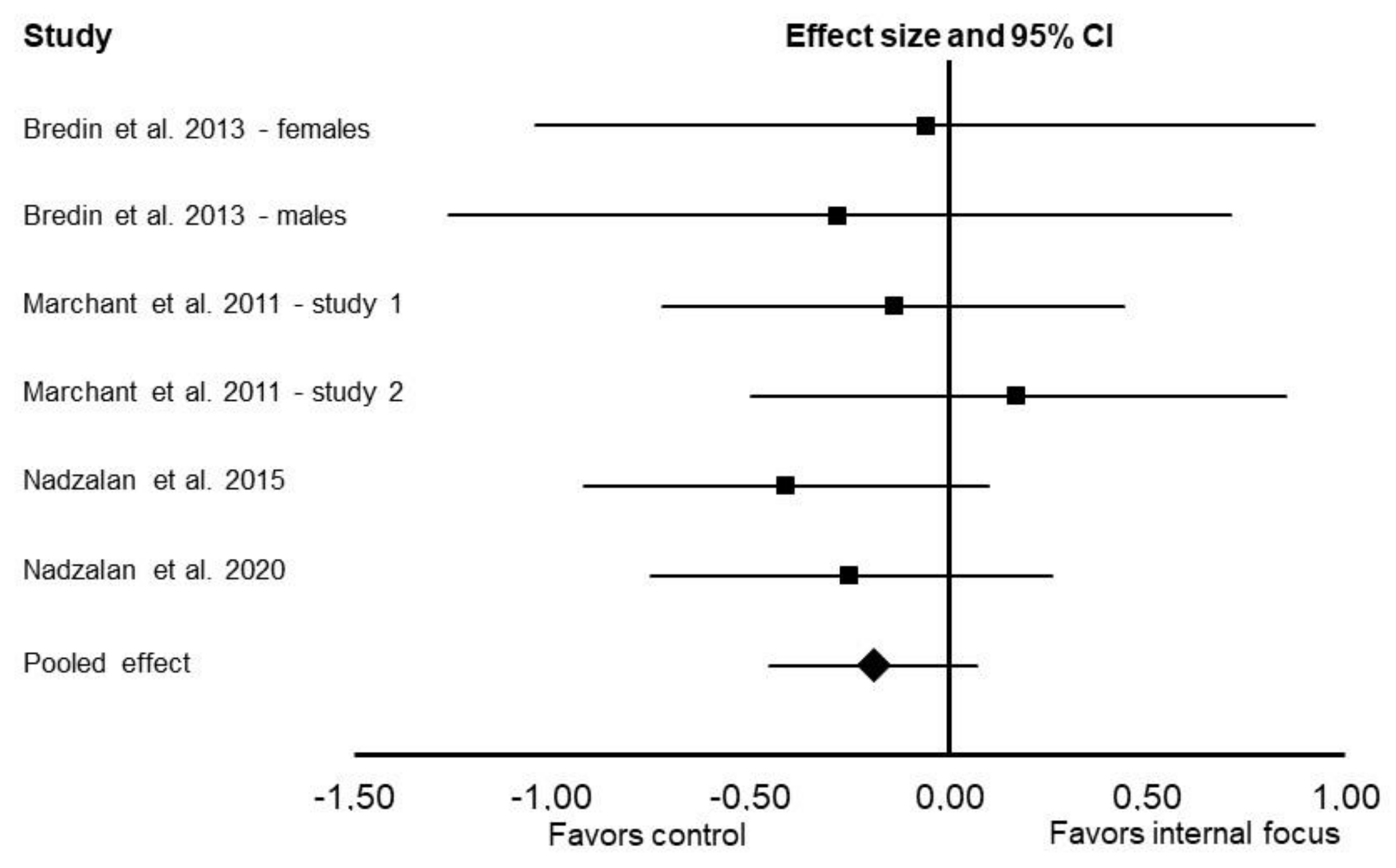Effects of Attentional Focus on Muscular Endurance: A Meta-Analysis
Abstract
:1. Introduction
2. Materials and Methods
2.1. Search Strategy
2.2. Inclusion Criteria
- 1.
- Published in English;
- 2.
- Utilized a crossover study design;
- 3.
- Examined the effects of external focus vs. internal focus on muscular endurance (with or without a control condition); and
- 4.
- Used an isotonic test of muscular endurance, where the outcome was the number of repetitions completed.
2.3. Data Extraction
- 1.
- Lead author name and the year of study publication;
- 2.
- Characteristics of the included participants;
- 3.
- Instructions provided to the participants during the experimental trials;
- 4.
- Description of the test used to evaluate muscular endurance; and
- 5.
- Mean ± standard deviation (SD) muscular endurance data from the experimental trials.
2.4. Methodological Quality
2.5. Statistical Analysis
3. Results
3.1. Search Results
3.2. Summary of Studies
3.3. Methodological Quality
3.4. Meta-Analysis Results
4. Discussion
5. Conclusions
Author Contributions
Funding
Institutional Review Board Statement
Informed Consent Statement
Data Availability Statement
Conflicts of Interest
References
- Wulf, G. Attentional focus and motor learning: A review of 15 years. Int. Rev. Sport. Exerc. Psychol. 2013, 6, 77–104. [Google Scholar] [CrossRef]
- Wulf, G.; Höß, M.; Prinz, W. Instructions for motor learning: Differential effects of internal versus external focus of attention. J. Mot. Behav. 1998, 30, 169–179. [Google Scholar] [CrossRef]
- Park, S.H.; Yi, C.W.; Shin, J.Y.; Ryu, Y.U. Effects of external focus of attention on balance: A short review. J. Phys. Ther. Sci. 2015, 27, 3929–3931. [Google Scholar] [CrossRef] [Green Version]
- Calatayud, J.; Vinstrup, J.; Jakobsen, M.D.; Sundstrup, E.; Brandt, M.; Jay, K.; Colado, J.C.; Andersen, L.L. Importance of mind-muscle connection during progressive resistance training. Eur. J. Appl. Physiol. 2016, 116, 527–533. [Google Scholar] [CrossRef]
- Vance, J.; Wulf, G.; Töllner, T.; McNevin, N.; Mercer, J. EMG activity as a function of the performer’s focus of attention. J. Mot. Behav. 2004, 36, 450–459. [Google Scholar] [CrossRef]
- Schoenfeld, B.J.; Contreras, B. Attentional focus for maximizing muscle development: The mind-muscle connection. Strength. Cond. J. 2016, 38, 27–29. [Google Scholar] [CrossRef] [Green Version]
- Kell, R.T.; Bell, G.; Quinney, A. Musculoskeletal fitness, health outcomes and quality of life. Sports Med. 2001, 31, 863–873. [Google Scholar] [CrossRef]
- Bredin, S.S.; Dickson, D.B.; Warburton, D.E. Effects of varying attentional focus on health-related physical fitness performance. Appl. Physiol. Nutr. Metab. 2013, 38, 161–168. [Google Scholar] [CrossRef]
- Collum, C.; Snarr, R.; Siekirk, N.; Wilson, S. Effects of attentional focus on repetitions-to-failure & motor unit excitation during submaximal bench press performance. Int. J. Strength Cond. 2021, 1, 1. [Google Scholar]
- Marchant, D.C.; Greig, M.; Bullough, J.; Hitchen, D. Instructions to adopt an external focus enhance muscular endurance. Res. Q. Exerc. Sport 2011, 82, 466–473. [Google Scholar] [CrossRef]
- Nadzalan, A.; Lee, J.; Mohamad, N. The effects of focus attention instructions on strength training performances. Int. J. Hum. Manag. Sci. 2015, 3, 418–423. [Google Scholar]
- Nadzalan, A.M.; Lee, J.L.F.; Mohamad, N.I.; Azzfar, M.S.; Abd Malek, N.F.; Waqqash, E. The effects of focus attention Instructions on the movement kinetics, muscle activation and performance during resistance exercise. J. Phys. Conf. Ser. 2020, 1529, 022008. [Google Scholar] [CrossRef]
- Neumann, D.L. A systematic review of attentional focus strategies in weightlifting. Front. Sports Act. Living 2019, 1, 7. [Google Scholar] [CrossRef] [PubMed] [Green Version]
- Marchant, D.C. Attentional focusing instructions and force production. Front. Psychol. 2011, 1, 210. [Google Scholar] [CrossRef] [Green Version]
- Maher, C.G.; Sherrington, C.; Herbert, R.D.; Moseley, A.M.; Elkins, M. Reliability of the PEDro scale for rating quality of randomized controlled trials. Phys. Ther. 2003, 83, 713–721. [Google Scholar] [CrossRef] [Green Version]
- Grgic, J.; Pickering, C. The effects of caffeine ingestion on isokinetic muscular strength: A meta-analysis. J. Sci. Med. Sport 2019, 22, 353–360. [Google Scholar] [CrossRef]
- Grgic, J. Caffeine ingestion enhances Wingate performance: A meta-analysis. Eur. J. Sport Sci. 2018, 18, 219–225. [Google Scholar] [CrossRef]
- Cohen, J. A power primer. Psychol. Bull. 1992, 112, 155–159. [Google Scholar] [CrossRef]
- Wulf, G.; McNevin, N.; Shea, C.H. The automaticity of complex motor skill learning as a function of attentional focus. Q. J. Exp. Psychol. 2001, 54, 1143–1154. [Google Scholar] [CrossRef]
- Wiseman, S.; Alizadeh, S.; Halperin, I.; Lahouti, B.; Snow, N.J.; Power, K.E.; Button, D.C. Neuromuscular mechanisms underlying changes in force production during an attentional focus task. Brain Sci. 2020, 10, 33. [Google Scholar] [CrossRef] [Green Version]
- Kuruganti, U.; Parker, P.; Rickards, J.; Tingley, M. Strength and muscle coactivation in older adults after lower limb strength training. Int. J. Ind. Ergon. 2006, 36, 761–766. [Google Scholar] [CrossRef]
- Lohse, K.R.; Sherwood, D.E. Defining the focus of attention: Effects of attention on perceived exertion and fatigue. Front. Psychol. 2011, 2, 332. [Google Scholar] [CrossRef] [Green Version]
- Duncan, M.J.; Oxford, S.W. Acute caffeine ingestion enhances performance and dampens muscle pain following resistance exercise to failure. J. Sports Med. Phys. Fitness 2012, 52, 280–285. [Google Scholar] [PubMed]
- Stoate, I.; Wulf, G. Does the attentional focus adopted by swimmers affect their performance? Int. J. Sports Sci Coach 2011, 6, 99–108. [Google Scholar] [CrossRef] [Green Version]
- Ducharme, S.W.; Wu, W.F.; Lim, K.; Porter, J.M.; Geraldo, F. Standing long jump performance with an external focus of attention is improved as a result of a more effective projection angle. J. Strength Cond. Res. 2016, 30, 276–281. [Google Scholar] [CrossRef]
- Wulf, G. Attentional focus and motor learning: A review of 10 years of research. Bewegung. Train. 2007, 1, 1–11. [Google Scholar]
- Ralston, G.W.; Kilgore, L.; Wyatt, F.B.; Baker, J.S. The effect of weekly set volume on strength gain: A meta-analysis. Sports Med. 2017, 47, 2585–2601. [Google Scholar] [CrossRef] [Green Version]
- Schoenfeld, B.J.; Ogborn, D.; Krieger, J.W. Dose-response relationship between weekly resistance training volume and increases in muscle mass: A systematic review and meta-analysis. J. Sports Sci. 2017, 35, 1073–1082. [Google Scholar] [CrossRef] [PubMed]
- Schoenfeld, B.J.; Contreras, B.; Krieger, J.; Grgic, J.; Delcastillo, K.; Belliard, R.; Alto, A. Resistance Training Volume Enhances Muscle Hypertrophy. Med. Sci. Sport Exerc. 2018, 51, 94–103. [Google Scholar] [CrossRef]
- Schoenfeld, B.J.; Fisher, J.P.; Grgic, J.; Haun, C.T.; Helms, E.T.; Phillips, S.M.; Steele, J.; Vigotsky, A.D. Resistance training recommendations to maximize muscle hypertrophy in an athletic population: Position stand of the IUSCA. Int. J. Strength Cond. 2021, 1, 1. [Google Scholar] [CrossRef]
- Nadzalan, A.M.; Lee, J.L.F.; Azzfar, M.S.; Muhammad, N.S.; Shukri, E.W.M.C.; Mohamad, N.I. The effects of resistance training with different focus attention on muscular strength: Application to teaching methods in physical conditioning class. IJITEE 2019, 8, 16–19. [Google Scholar]
- Grgic, J.; Mikulic, I.; Mikulic, P. Acute and Long-Term Effects of Attentional Focus Strategies on Muscular Strength: A Meta-Analysis. Sports 2021, 9, 153. [Google Scholar] [CrossRef] [PubMed]
- Schoenfeld, B.J.; Vigotsky, A.; Contreras, B.; Golden, S.; Alto, A.; Larson, R.; Winkelman, N.; Paoli, A. Differential effects of attentional focus strategies during long-term resistance training. Eur. J. Sport Sci. 2018, 18, 705–712. [Google Scholar] [CrossRef] [PubMed]




| Study | Participants | Participants Characteristics | External Focus Instructions | Internal Focus Instructions | Muscular Endurance Test a | PEDro Score |
|---|---|---|---|---|---|---|
| Bredin et al. [8] * | 16 young adults (8F/8M) | Age: 21 to 33 years; 1RM: n/a | Direct the concentration toward the floor as they completed each push-up | Concentrate on the arm muscles | Push-ups | 6 |
| Collum et al. [9] * | 25 resistance-trained participants (9F/16M) b | Age: 22 ± 2 years; 1RM: 76 ± 27 kg | “Drive the weight towards the ceiling” | “Drive the weight with your chest” | Bench press at 85% 1RM | 6 |
| Marchant et al. [10] – study 1 ** | 23 resistance-trained participants (7F/16M) | Age: 31 ± 12 years; 1RM: n/a | “Focus on moving and exerting force through and against the barbell” | “Focus on moving and exerting force with your arms” | Smith machine bench press with 40 kg (males) or 20 kg (females) | 5 |
| Marchant et al. [10] – study 2 ** | 17 resistance-trained participants (17M) | Age: 21 ± 1 years; Bench press 1RM: 95 ± 20 kg Squat 1RM: 184 ± 36 kg | Bench press: “focus on moving and exerting force through and against the barbell”Squat: “focus on moving and exerting force through and against the barbell” | Bench press: “focus on moving and exerting force with your arms” Squat: “focus on moving and exerting force with your legs” | Bench press and squat at 75% 1RM | 5 |
| Nadzalan et al. [11] * | 30 resistance-trained participants (30M) | Age: 22 ± 1 years; Bench press 1RM: 75 ± 24 kg Deadlift 1RM: 143 ± 8 kg | Bench press: “focus on exerting force through and against the barbell” Deadlift: “focus your attention on pulling the bar up” | Bench press: “focus on exerting force with the arm” Deadlift: “focus your attention on extending your knees and hips” | Bench press and deadlift at 80% 1RM | 6 |
| Nadzalan et al. [12] ** | 30 resistance-trained participants (30M) | Age: 21 ± 1 years; Squat 1RM: 106 ± 13 kg Deadlift 1RM: 122 ± 13 kg | Squat: “focus on moving and exerting force through and against the barbell” Deadlift: “focus your attention on pulling the bar up” | Squat: “focus on moving and exerting force with your legs” Deadlift: “focus your attention on extending your knees and hips” | Squat and deadlift at 80% 1RM | 5 |
Publisher’s Note: MDPI stays neutral with regard to jurisdictional claims in published maps and institutional affiliations. |
© 2021 by the authors. Licensee MDPI, Basel, Switzerland. This article is an open access article distributed under the terms and conditions of the Creative Commons Attribution (CC BY) license (https://creativecommons.org/licenses/by/4.0/).
Share and Cite
Grgic, J.; Mikulic, P. Effects of Attentional Focus on Muscular Endurance: A Meta-Analysis. Int. J. Environ. Res. Public Health 2022, 19, 89. https://doi.org/10.3390/ijerph19010089
Grgic J, Mikulic P. Effects of Attentional Focus on Muscular Endurance: A Meta-Analysis. International Journal of Environmental Research and Public Health. 2022; 19(1):89. https://doi.org/10.3390/ijerph19010089
Chicago/Turabian StyleGrgic, Jozo, and Pavle Mikulic. 2022. "Effects of Attentional Focus on Muscular Endurance: A Meta-Analysis" International Journal of Environmental Research and Public Health 19, no. 1: 89. https://doi.org/10.3390/ijerph19010089
APA StyleGrgic, J., & Mikulic, P. (2022). Effects of Attentional Focus on Muscular Endurance: A Meta-Analysis. International Journal of Environmental Research and Public Health, 19(1), 89. https://doi.org/10.3390/ijerph19010089





